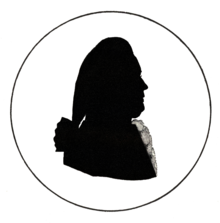Johan Lexell is different
Anders Johan Lexell (* 24. December 1740 in Turku , † November 30 . Jul / 11 December 1784 greg. In Saint Petersburg ) was a Finland Swedish -born, later to Russia emigrated astronomer and mathematician . The Russian spelling of his name is Andrei Iwanowitsch Leksel ( Андрей Иванович Лексель ). Other spelling variants are Anders Johann Lexell or Johann Anders Lexell .
Live and act
Lexell was born in Åbo (now Turku) to Johan Lexell, a goldsmith and administrator, and Madeleine-Catherine Björkegren. At the time of his birth, the city belonged to the Swedish Empire and his parents were members of the Swedish population in Finland. After studying at the Åbo Academy , he received his doctorate in philosophy with his thesis Aphorismi mathematico-physici . His doctoral supervisor was Jakob Gadolin . In 1763 he moved to Uppsala and taught as a mathematics lecturer at the local university and from 1766 as a professor of mathematics at the Maritime School in Uppsala. With the work Methodus integrandi nonnulis aequationum exemplis illustrata , Lexell was appointed associate professor to Saint Petersburg at the suggestion of Leonhard Euler . In 1771 he became a full member of the Russian Academy of Sciences . 1780–81 he went on a study trip through Germany, France, the Netherlands, England and Sweden. In St. Petersburg he was close friends with Leonhard Euler and after his death in 1783 he became his successor in St. Petersburg, but died only a year later. In the year of his death in 1784 he was elected a member of the Royal Society of Edinburgh . From 1776 he was a corresponding member of the Académie des Sciences in Paris.
Lexell's main field of work was celestial mechanics . He calculated the movements of comets and other celestial bodies. In 1769 he investigated the transit of Venus in St. Petersburg with Christian Mayer . This made it possible for him to calculate the parallax of the sun . He calculated the orbit of comet D / 1770 L1 (Lexell), which was then named after him, although it was discovered by Charles Messier . This comet came closest to Earth of all comets, only a few asteroids came even closer. Comet Lexell became the first near-Earth object ; its exact distance has not been measured, but it is believed that it flew past Earth at a distance of no more than 3 million kilometers.
Lexell helped Euler develop his theory of the moon and was a co-author of Euler's Theoria motuum Lunae , published in 1772 .
Lexell was also the first to determine the orbit of the planet Uranus shortly after its discovery by Wilhelm Herschel in 1781. He realized that it was not a comet, as initially assumed, but a planet. He also recognized that the movement of Uranus was disturbed by another object , and assumed that the cause was a planet that was still unknown at the time, but whose position could not yet be calculated at that time. This was achieved more than 60 years later by Urbain Le Verrier , whose calculations led to the discovery of the planet Neptune .
The lunar crater Lexell and the asteroid (2004) Lexell are named after him.
literature
- Johan Stén: A comet of the enlightment: Anders Johan Lexell's life and discoveries , Vita mathematica, Birkhäuser / Springer 2014
Individual evidence
- ^ Fellows Directory. Biographical Index: Former RSE Fellows 1783–2002. (PD) Royal Society of Edinburgh, accessed January 1, 2020 .
- ^ List of members since 1666: Letter L. Académie des sciences, accessed on January 13, 2020 (French).
- ^ AJ Lexell: Disquisitio de investiganda vera quantitate parallaxeos Solis, et transitu Veneris ante discum solis anno 1769, cui accedunt animadversiones in tractatum rev. pat. Hell de parallaxi Solis . 1772, p. 131 .
- ↑ JA Euler, WL Krafft, JA Lexell: Theoria motuum lunae, nova methodo pertractata una cum tabulis astronomicis, unde ad quodvis tempus loca lunae expedite computari possunt, incredibili studio atque indefesso labore trium Academicorum: Johannis Alberti Euler, Wolffgangi Andrea, Wolffgangi Andrea Lexel. Opus conductor Leonardo Eulero . 1772, p. 775 .
- ^ AJ Lexell: Recherches sur la nouvelle planete, decouverte par M. Herschel & nominee Georgium Sidus . In: Acta Academia Scientarum Imperialis Petropolitanae . tape 1 , 1783, p. 303-329 .
Web links
- Anders Johan Lexell exchanged letters with Carl von Linné
- John J. O'Connor, Edmund F. Robertson : Anders Johan Lexell. In: MacTutor History of Mathematics archive .
| personal data | |
|---|---|
| SURNAME | Lexell, Anders Johan |
| ALTERNATIVE NAMES | Leksel, Andrei Ivanovich |
| BRIEF DESCRIPTION | Astronomer and mathematician |
| DATE OF BIRTH | December 24, 1740 |
| PLACE OF BIRTH | Turku |
| DATE OF DEATH | December 11, 1784 |
| Place of death | St. Petersburg |

